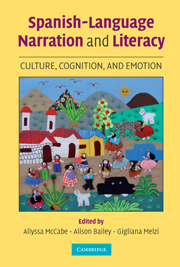Book contents
- Frontmatter
- Contents
- List of Contributors
- Preface
- Acknowledgments
- 1 Introduction
- PART ONE PARENT–CHILD NARRATIVES
- PART TWO DEVELOPING INDEPENDENT NARRATION
- 7 The Intersection of Language and Culture Among Mexican-Heritage Children 3 to 7 Years Old
- 8 Beyond Chronicity: Evaluation and Temporality in Spanish-Speaking Children's Personal Narratives
- 9 Narrative Stance in Venezuelan Children's Stories
- 10 Mestizaje: Afro-Caribbean and Indigenous Costa Rican Children's Narratives and Links with Other Traditions
- PART THREE NARRATIVE LINKS TO LITERACY AND OTHER SCHOOL ACHIEVEMENTS
- Author Index
- Subject Index
- References
8 - Beyond Chronicity: Evaluation and Temporality in Spanish-Speaking Children's Personal Narratives
Published online by Cambridge University Press: 05 June 2012
- Frontmatter
- Contents
- List of Contributors
- Preface
- Acknowledgments
- 1 Introduction
- PART ONE PARENT–CHILD NARRATIVES
- PART TWO DEVELOPING INDEPENDENT NARRATION
- 7 The Intersection of Language and Culture Among Mexican-Heritage Children 3 to 7 Years Old
- 8 Beyond Chronicity: Evaluation and Temporality in Spanish-Speaking Children's Personal Narratives
- 9 Narrative Stance in Venezuelan Children's Stories
- 10 Mestizaje: Afro-Caribbean and Indigenous Costa Rican Children's Narratives and Links with Other Traditions
- PART THREE NARRATIVE LINKS TO LITERACY AND OTHER SCHOOL ACHIEVEMENTS
- Author Index
- Subject Index
- References
Summary
Key Words: narrative, language development, Andean, Spanish-speaking children, temporality, evaluation
ABSTRACT
This chapter focuses on Spanish-speaking children's evaluation and temporality in the construction of personal narratives. The study analyzes 32 personal narratives produced by 8 Andean Spanish-speaking children from the Andean city of Cusco in Peru. All children were monolingual speakers of the Andean Spanish variety and came from lower-middle-class families. Half the children were preschoolers (4;9 to 5;5 years) and the other half were first-graders (6;6 to 7;8 years). Both age groups were balanced in terms of gender. Children were interviewed and tape-recorded by the author using the Conversational Map of Narratives of Real Experiences (McCabe & Rollins, 1994) as the elicitation procedure. Narratives were transcribed using CHAT conventions (MacWhinney, 2000) and were subsequently coded for narrative components (Peterson & McCabe, 1983) and temporal organization (Genette, 1980). Results indicated that contrary to the sequentiality and single-story structure reported as characteristic of U.S. European American English-speaking children, these Andean Spanish-speaking children's narratives present a distinctive feature labeled herein as structural evaluation. Structural evaluation takes two forms, either (1) a functional deviation from the timeline of real events; or (2) a chain of independent stories connected within the boundaries of a single narrative. These young narrators used these strategies to evaluate a specific point in the narrative, consequently affecting both the temporal organization of events and the episodic complexity of the narratives.
- Type
- Chapter
- Information
- Spanish-Language Narration and LiteracyCulture, Cognition, and Emotion, pp. 175 - 212Publisher: Cambridge University PressPrint publication year: 2008
References
- 9
- Cited by



